PHOTOS BY BECCA DILLEY / ILLUSTRATION BY WACSO / HEAVY TABLE
You might as well know, right at the outset, that Alice Waters does not approve of walking tacos.
The iconic chef’s first encounter with the dish-in-a-bag came during a trip to a school after the principal asked for her assistance with the food program. Waters describes the scene in her 2008 book Edible Schoolyard:
Parked in the middle of the asphalt, this building sold soda pop to the children during their recess and lunch hour, and it also sold something called a “walking taco,” which is as perfect a symbol of a broken culture as I can imagine. Opening a plastic bag of mass-produced corn chips, the food workers would simply pour in a kind of beef-and-tomato slurry from a can. The kids would then walk away, with no connection to one another.
If there’s such a thing as the opposite of Proust’s madeleine, this is it: a childhood experience, first encountered in adulthood, and repulsing in some formative way. The moment was the seed of Waters’ work with kids—planting vegetable gardens on school grounds; understanding where their food comes from; learning to eat fresh, healthful things. All good and noble and important work!
But I can’t help but wince at her broader critique: “As perfect a symbol of a broken culture as I can imagine.” Because while a walking taco may not be, like, good for you in a nutritionist-approved way, if you look at the deeper cultural perspective, it turns out there’s much to savor—it’s less about how things fall apart than how they come together.
* * *
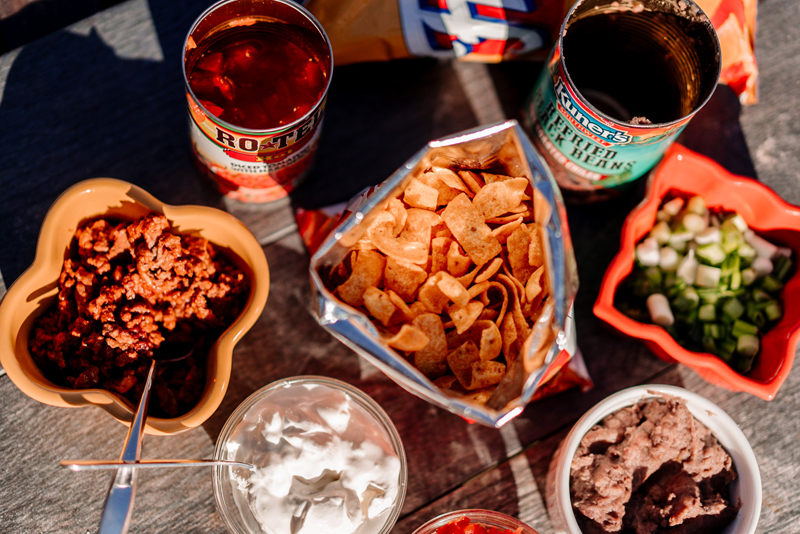 I was well into my 30s before I encountered my first walking taco. My wife and I went to her aunt and uncle’s house in the Twin Cities suburbs for a big family gathering—more aunts, more uncles, assorted cousins—and on the kitchen counter, a large spread of food was laid out, with a pile of Frito bags front and center, flanked by bowls of seasoned ground beef, chopped lettuce, shredded cheese, diced tomatoes, and assorted other white-Midwesterner taco toppings. (Were there black olives? I don’t remember, but probably.)
I was well into my 30s before I encountered my first walking taco. My wife and I went to her aunt and uncle’s house in the Twin Cities suburbs for a big family gathering—more aunts, more uncles, assorted cousins—and on the kitchen counter, a large spread of food was laid out, with a pile of Frito bags front and center, flanked by bowls of seasoned ground beef, chopped lettuce, shredded cheese, diced tomatoes, and assorted other white-Midwesterner taco toppings. (Were there black olives? I don’t remember, but probably.)
“We’re having walking tacos!” someone said. Various young cousins’ eyes lit up; I tilted my head in confusion until the hosting aunt explained: “You open a bag of chips, add the taco ingredients you like, shake it all up…and enjoy.”
It was, of course, delicious, because all of those things are delicious together. (I grew up on the same basic thing, but in Ortega shells; only the concept of putting it all in a chip bag was new to me.) It was novel and intriguing and fun, in a way that all food should be, fostering the same sense of delight that, I presume, first led someone to put taco fixings in a bag and mix it all up like that.
When you go looking for who, exactly, that original genius was, you find competing claims, as you do with so many great foods, like the Ju(i)cy Lucy or the chimichanga. And to tell that story, you have to know that a walking taco is simply another name for Frito pie—specifically, walking Frito pie (putting it all in a bag is the key here)—or as a Petro, if you’re buying it at the Tennessee-based fast food chain of the same name (about which more shortly).
As it happens, back in 1986, Frito-Lay hired a historian to research this, a man named Ed “Chill Lee” Paetzel (say the nickname out loud). According to his findings, the origins of Frito pie probably go back to Daisy Dean Doolin, the mother of Elmer Doolin, the founder of the Frito company (though it was a Oaxacan immigrant named Gustavo Olquin who created the Frito chip itself). Ms. Doolin was known to tinker with recipes involving the chips, including an early effort called—take note, holiday-season bakers—“Fritos Fruit Cake,” which included “candied fruits, pecans and crushed Fritos,” according to an excellent history published by Smithsonian a few years back.
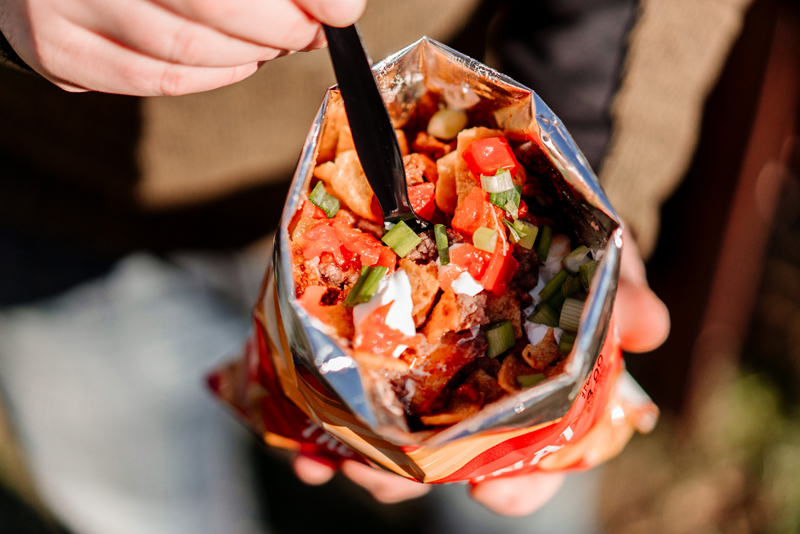 If it’s in Smithsonian and confirmed by Frito-Lay, it may seem like corn chip canon, but head to Santa Fe and you’ll hear a different story. Here, the originator is Teresa Hernandez, who died last year at 88 and whose obituary in the local newspaper mentioned Frito pie in the first sentence: “Among Teresa Hernandez’s passions were colcha embroidery, watching Spanish-language novelas, and making the famed Frito pie — a combo of beans, red chile, Fritos chips, cheese and onions that arguably should have been trademarked decades ago by the Woolworth’s store on the Santa Fe Plaza or its successor, the Five and Dime General Store.”
If it’s in Smithsonian and confirmed by Frito-Lay, it may seem like corn chip canon, but head to Santa Fe and you’ll hear a different story. Here, the originator is Teresa Hernandez, who died last year at 88 and whose obituary in the local newspaper mentioned Frito pie in the first sentence: “Among Teresa Hernandez’s passions were colcha embroidery, watching Spanish-language novelas, and making the famed Frito pie — a combo of beans, red chile, Fritos chips, cheese and onions that arguably should have been trademarked decades ago by the Woolworth’s store on the Santa Fe Plaza or its successor, the Five and Dime General Store.”
In this telling, Hernandez started working at the store in the early 1950s, when she was 18 or 19 years old, and had the idea to start selling the taco-adjacent food at the store’s walk-up counter—slice open the bag, add chile, cheese, and onions, exchange some money, enjoy. It was an immediate hit, and soon enough, the five-and-dime was selling 30,000 bags every year. In Hernandez’s obituary, her nephew said that the only time she ever got upset was “when others would claim they were responsible for creating the Frito pie.”
There’s one more origin story to consider, although this one is less about invention than popularization, and it starts around 1980, with a Seattle ticket agent named Joe Schoentrup, who wanted to sell something at the upcoming World’s Fair in Knoxville, in 1982. His sister suggested a food she’d seen once in the Dallas area—chili plus taco toppings, mixed into a bag of Fritos—and Joe Schoentrup decided to do it, with a slight twist. “We really started adding the gourmet to them,” he told the Washington Post, which called it “a tasty product of American ingenuity.” His ingredient list: “the bags of chips and canned chili with shredded cheddar and monterey jack cheese, chopped scallions, chopped tomatoes, sour cream and a dash of hot sauce.” Schoentrup called it a “Petro,” a play on petroleum, and a nod to the fair’s theme, which was energy. (Schoentrop also sold plain, unadorned bags of Fritos as “Unleaded Petros,” which is how I what I will now write instead of “chips” on my own grocery list.) Petros were a hit at the World’s Fair and again at the Louisiana Expo in 1984, and led to a small chain of restaurants that now has seventeen stores in four states.
It does seem plausible that the Petro helped the Frito pie, as a concept, spread around the USA. The timing works out, anyway—search the news archives, and you’ll see that mentions of “Frito pie” start to rise by the middle of the 1980s (not so with the term “Petro,” specifically), often in conjunction with various fairs and festivals. By 1989, it was sufficiently well-known that food writer Calvin Trillin used it in a riff on how then-President George H.W. Bush could become more relatable to everyday Americans: “I suggest he reveal an addiction to Frito pie.”
* * *
It makes sense that this portable edible would be popular at events and festivals, far beyond the World’s Fair. Have you been to the Minnesota State Fair? There’s no blue ribbon for “most elaborate thing you can eat while meandering around the fairgrounds,” but we all know this is the most important competition in the whole place. Which brings us back to the walking taco—not just the concept but the precise term.
I’ve been digging through newspaper archives to find its origins, which hasn’t led to anything conclusive but does turn up a whole lot of event listings across the Midwest. The earliest one I’ve found is from the Grand Rapids (Michigan) Festival of the Arts, in 1994, when the typical line-up of foods was expanded to include “several new entries, including potato pancakes, caramel apple chips and popcorn, potatoes with cheese sauce, chicken pikka, something called a walking taco and Syrian meat pie.”
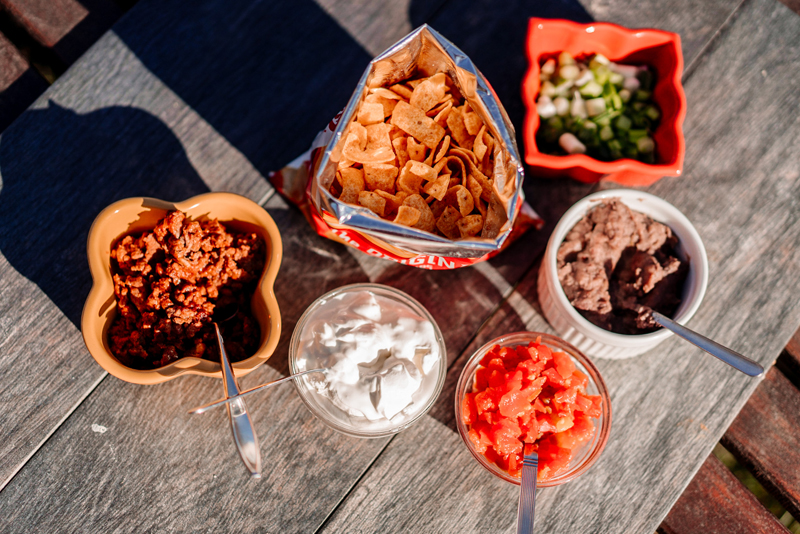 It’s interesting, I think, that chicken pikka (not tikka, at least not in the event listing) and Syrian meat pie are both listed without comment, but it’s “something called” a walking taco. There’s an added level of mystery—or perhaps confusion—here, one that signals that it’s something truly new, at least in this part of the world. In any case, it clearly found an audience, because it came back, becoming a staple of the festival, at a booth run by local Mormons (Question for future researchers: Did Mormon missionaries bring it back from Texas or New Mexico to the Upper Midwest and then rebrand it? Please investigate.) In 1997, a post-event write-up for the same festival noted that “Jesus Christ of Latter Day Saints members ran out of their popular ‘walking taco’” before the event was over.
It’s interesting, I think, that chicken pikka (not tikka, at least not in the event listing) and Syrian meat pie are both listed without comment, but it’s “something called” a walking taco. There’s an added level of mystery—or perhaps confusion—here, one that signals that it’s something truly new, at least in this part of the world. In any case, it clearly found an audience, because it came back, becoming a staple of the festival, at a booth run by local Mormons (Question for future researchers: Did Mormon missionaries bring it back from Texas or New Mexico to the Upper Midwest and then rebrand it? Please investigate.) In 1997, a post-event write-up for the same festival noted that “Jesus Christ of Latter Day Saints members ran out of their popular ‘walking taco’” before the event was over.
By the end of the decade, walking tacos were at street festivals and county fairs all over the Midwest, fitting into the ever-broadening contours of the American culinary landscape, including populist, portable subset found at large events. Here’s a recap of one reporter’s feast at Octoberfest in Appleton, Wisconsin, in 1999: “Eating his way through Saturday’s event by indulging in a gyro, a pair of Thai beef sticks, an egg roll and Cajun sausage and gumbo, DeLuca dug into his ‘walking taco,’ a bag of Fritos with meat, cheese, lettuce and sour cream tossed inside. ‘Now this is an ingenious idea. The bag acts like a bowl. It’s mess-free and you don’t have to sit down to eat it,’ he said.”
Again, notice what’s described in detail and what’s assumed to be familiar—it’s still not entirely an established foodstuff, but it’s slowly making its way to that point. By 2000, walking tacos were on offer at events as disparate as a street fair in Evansville, Indiana; a high school sports fundraiser in Dayton, Ohio; and a fundraiser party for the Sisters of the Holy Family of Nazareth in Des Plaines, Illinois, where it was a star attraction, along with a petting zoo and a climbing wall. It may not have been quite the regional equivalent of the wonders and extravagances of fin de siècle Paris a century earlier, but it’s easy to imagine a happy fair-wanderer taking in the scene, walking taco in hand, and thinking, This is the life.
* * *
It’s important to place walking tacos and Frito pies and Petros in the context of Mexican food—and its evolution—in the USA. “Tacos reflect and represent their time and place,” José R. Ralat, Texas Monthly’s taco editor, wrote last year in a long story about Kansas City’s Parmesan-coated tacos, placing them in a broader history that includes tacos Árabes, Korean barbecue tacos, vegetarian jackfruit tacos, and other variations. Even the taco salad—that staple of school lunchrooms, and seemingly as inauthentic as it gets—comes with a backstory involving a restaurant run by a Mexican family, even if that restaurant happened to be at Disneyland, as Gustavo Arellano documents in his book Taco USA (and, more recently, in a story for OC Weekly).
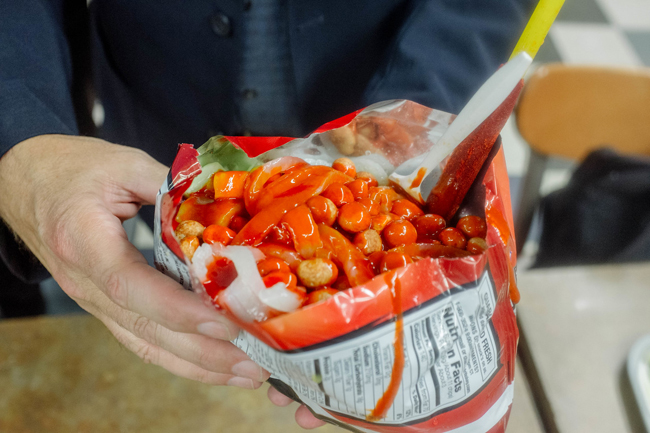 Which brings us to the most recent variation on the theme of chips-plus-other-things: Dorilocos and Tostilocos, which you can find locally, among other places, at La Michoacana and Below Zero in Mercado Central. If you’re not familiar with these delicacies, well, here’s how Heavy Table described it in the original East Lake Checklist a few years ago:
Which brings us to the most recent variation on the theme of chips-plus-other-things: Dorilocos and Tostilocos, which you can find locally, among other places, at La Michoacana and Below Zero in Mercado Central. If you’re not familiar with these delicacies, well, here’s how Heavy Table described it in the original East Lake Checklist a few years ago:
OK. Let’s see here. So, you get a bag of Doritos. You rip it open and add some combination of: lime juice, hot sauce, jicama, mango, pineapple, cueritos (pickled pig skin), chile powder, and “Japanese peanuts,” which are peanuts battered and deep fried. Stick in a straw wrapped in tamarind. Dig in! It’s chips! It’s hot sauce! It’s pickled pig skin! It’s sweet. It’s spicy. It’s earthy. It’s pickled. It’s just about everything possible, and literally a bag of chips. Words like “good” or “bad” or “tasty” do this cross-cultural mashup no justice whatsoever. It’s an experience.
 If that seems like a direct adaptation of walking tacos, it’s not, says Arellano. Instead, it’s something that developed organically in Mexico around 2000, as a way of taking the corporate versions of fried tortillas—that is, Tostitos, Doritos, and Fritos—and “claiming [them] for Mexicans by adding a bunch of stuff on top,” he told the New York Times in 2012. “That’s what people in Mexico do with anything that comes down from somewhere else. We change it, we add more ingredients, more toppings.”
If that seems like a direct adaptation of walking tacos, it’s not, says Arellano. Instead, it’s something that developed organically in Mexico around 2000, as a way of taking the corporate versions of fried tortillas—that is, Tostitos, Doritos, and Fritos—and “claiming [them] for Mexicans by adding a bunch of stuff on top,” he told the New York Times in 2012. “That’s what people in Mexico do with anything that comes down from somewhere else. We change it, we add more ingredients, more toppings.”
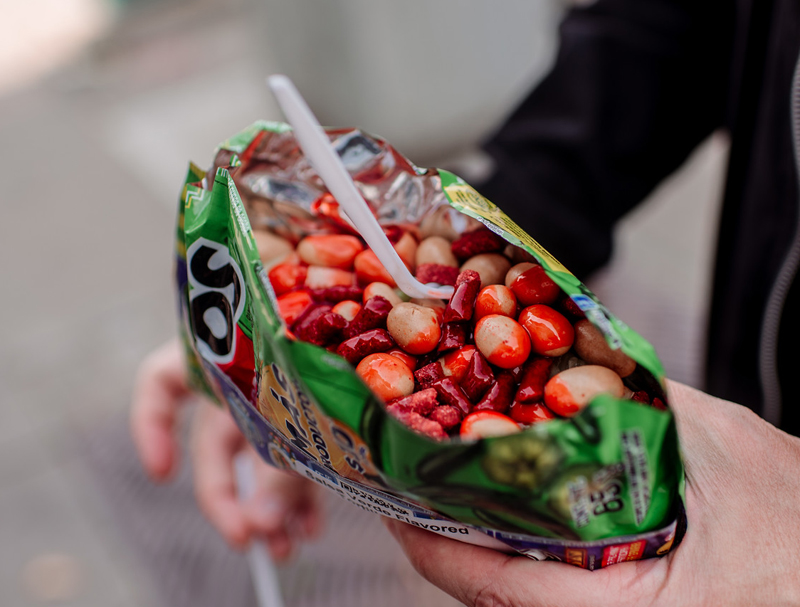 As with so many foods before them, Dorilocos and Tostilocos have now made their way here to Minnesota. I haven’t seen them at any relatives’ houses lately—even before the pandemic halted such gatherings—but I look forward to swinging by La Michoacana sometime in the future, on my way to some big shindig at that house in the suburbs.
As with so many foods before them, Dorilocos and Tostilocos have now made their way here to Minnesota. I haven’t seen them at any relatives’ houses lately—even before the pandemic halted such gatherings—but I look forward to swinging by La Michoacana sometime in the future, on my way to some big shindig at that house in the suburbs.
“Dorilocos are a fundamentally rebellious food,” Daniela Galarza wrote in Eater a while back. “They’re unglamorous, the opposite of farm-to-table or artisanal or sustainable. They’re not healthy. They’re not traditional. (At least not yet.) But when I took that first bite, I realized something: They taste spectacular.”
That last part is undeniable (sorry, Alice Waters), but beyond that, there’s an interesting story to tell, just as there’s a story to tell about Frito pie and walking tacos—a tale of cultures interacting over the decades, a call and response sprinkled with lettuce and/or candy. And that history, too, is an intriguing, spectacular thing in its own right.
Update, Feb. 3, 2021: The spelling of the last name of author Gustavo Arellano was corrected.
Doug Mack is the author of The Not-Quite States of America (W.W. Norton, 2017). He has written for The New York Times, Slate, and Time, and is the Editor-at-Large for The Statesider. He lives in Minneapolis and tweets @douglasmack.

